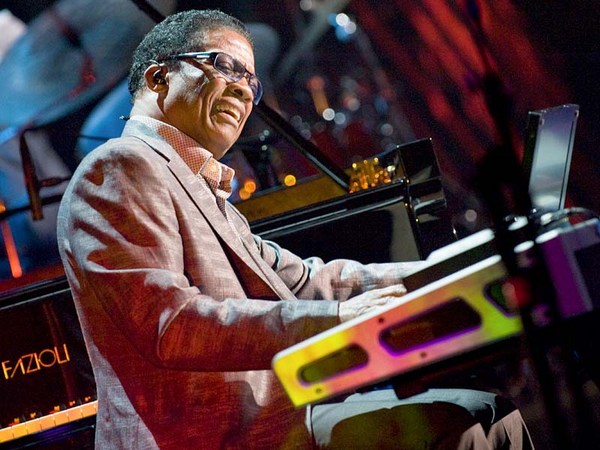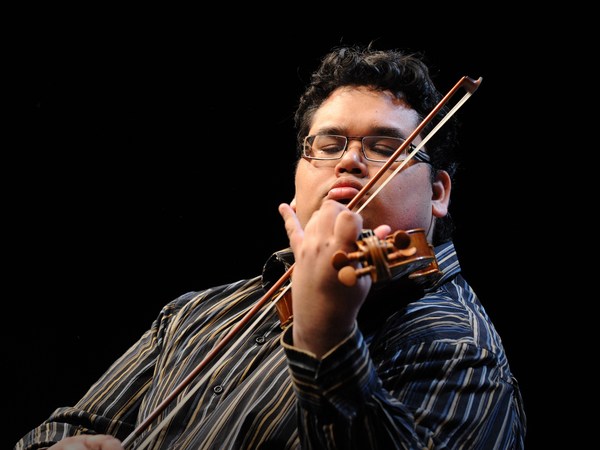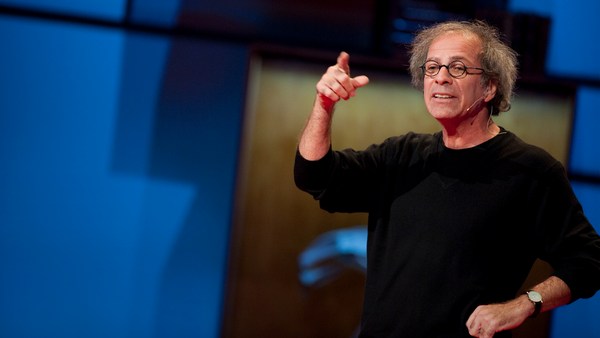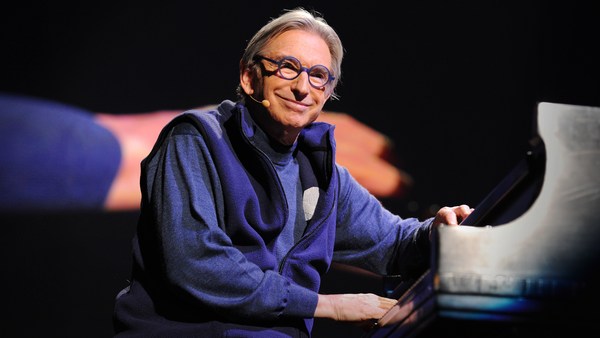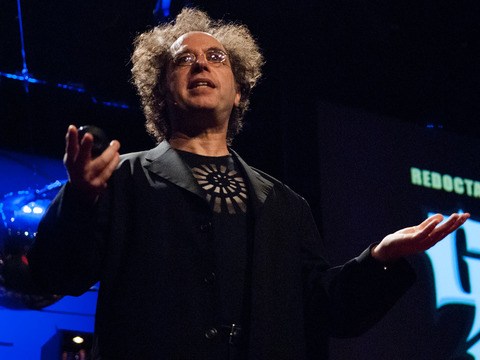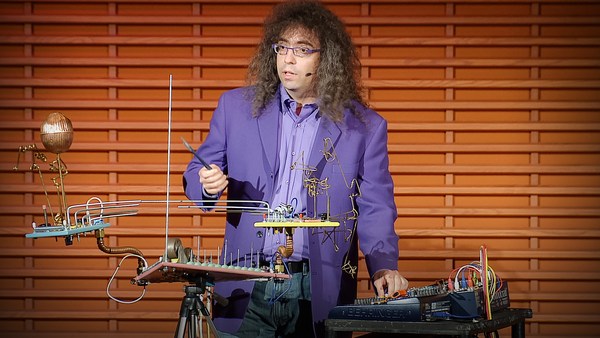This is the venue where, as a young man, some of the music that I wrote was first performed. It was, remarkably, a pretty good sounding room. With all the uneven walls and all the crap everywhere, it actually sounded pretty good. This is a song that was recorded there. (Music) This is not Talking Heads, in the picture anyway. (Music: "A Clean Break (Let's Work)" by Talking Heads) So the nature of the room meant that words could be understood. The lyrics of the songs could be pretty much understood. The sound system was kind of decent. And there wasn't a lot of reverberation in the room. So the rhythms could be pretty intact too, pretty concise. Other places around the country had similar rooms. This is Tootsie's Orchid Lounge in Nashville. The music was in some ways different, but in structure and form, very much the same. The clientele behavior was very much the same too. And so the bands at Tootsie's or at CBGB's had to play loud enough -- the volume had to be loud enough to overcome people falling down, shouting out and doing whatever else they were doing.
Since then, I've played other places that are much nicer. I've played the Disney Hall here and Carnegie Hall and places like that. And it's been very exciting. But I also noticed that sometimes the music that I had written, or was writing at the time, didn't sound all that great in some of those halls. We managed, but sometimes those halls didn't seem exactly suited to the music I was making or had made. So I asked myself: Do I write stuff for specific rooms? Do I have a place, a venue, in mind when I write? Is that a kind of model for creativity? Do we all make things with a venue, a context, in mind?
Okay, Africa. (Music: "Wenlenga" / Various artists) Most of the popular music that we know now has a big part of its roots in West Africa. And the music there, I would say, the instruments, the intricate rhythms, the way it's played, the setting, the context, it's all perfect. It all works perfect. The music works perfectly in that setting. There's no big room to create reverberation and confuse the rhythms. The instruments are loud enough that they can be heard without amplification, etc., etc. It's no accident. It's perfect for that particular context. And it would be a mess in a context like this. This is a gothic cathedral. (Music: "Spem In Alium" by Thomas Tallis) In a gothic cathedral, this kind of music is perfect. It doesn't change key, the notes are long, there's almost no rhythm whatsoever, and the room flatters the music. It actually improves it. This is the room that Bach wrote some of his music for. This is the organ. It's not as big as a gothic cathedral, so he can write things that are a little bit more intricate. He can, very innovatively, actually change keys without risking huge dissonances. (Music: "Fantasia On Jesu, Mein Freunde" by Johann S. Bach)
This is a little bit later. This is the kind of rooms that Mozart wrote in. I think we're in like 1770, somewhere around there. They're smaller, even less reverberant, so he can write really frilly music that's very intricate -- and it works. (Music: "Sonata in F," KV 13, by Wolfgang A. Mozart) It fits the room perfectly. This is La Scala. It's around the same time, I think it was built around 1776. People in the audience in these opera houses, when they were built, they used to yell out to one another. They used to eat, drink and yell out to people on the stage, just like they do at CBGB's and places like that. If they liked an aria, they would holler and suggest that it be done again as an encore, not at the end of the show, but immediately. (Laughter) And well, that was an opera experience. This is the opera house that Wagner built for himself. And the size of the room is not that big. It's smaller than this. But Wagner made an innovation. He wanted a bigger band. He wanted a little more bombast, so he increased the size of the orchestra pit so he could get more low-end instruments in there. (Music: "Lohengrin / Prelude to Act III" by Richard Wagner)
Okay. This is Carnegie Hall. Obviously, this kind of thing became popular. The halls got bigger. Carnegie Hall's fair-sized. It's larger than some of the other symphony halls. And they're a lot more reverberant than La Scala. Around the same, according to Alex Ross who writes for the New Yorker, this kind of rule came into effect that audiences had to be quiet -- no more eating, drinking and yelling at the stage, or gossiping with one another during the show. They had to be very quiet. So those two things combined meant that a different kind of music worked best in these kind of halls. It meant that there could be extreme dynamics, which there weren't in some of these other kinds of music. Quiet parts could be heard that would have been drowned out by all the gossiping and shouting. But because of the reverberation in those rooms like Carnegie Hall, the music had to be maybe a little less rhythmic and a little more textural. (Music: "Symphony No. 8 in E Flat Major" by Gustav Mahler) This is Mahler. It looks like Bob Dylan, but it's Mahler. That was Bob's last record, yeah.
(Laughter)
Popular music, coming along at the same time. This is a jazz band. According to Scott Joplin, the bands were playing on riverboats and clubs. Again, it's noisy. They're playing for dancers. There's certain sections of the song -- the songs had different sections that the dancers really liked. And they'd say, "Play that part again." Well, there's only so many times you can play the same section of a song over and over again for the dancers. So the bands started to improvise new melodies. And a new form of music was born. (Music: "Royal Garden Blues" by W.C. Handy / Ethel Waters) These are played mainly in small rooms. People are dancing, shouting and drinking. So the music has to be loud enough to be heard above that. Same thing goes true for -- that's the beginning of the century -- for the whole of 20th-century popular music, whether it's rock or Latin music or whatever. [Live music] doesn't really change that much.
It changes about a third of the way into the 20th century, when this became one of the primary venues for music. And this was one way that the music got there. Microphones enabled singers, in particular, and musicians and composers, to completely change the kind of music that they were writing. So far, a lot of the stuff that was on the radio was live music, but singers, like Frank Sinatra, could use the mic and do things that they could never do without a microphone. Other singers after him went even further. (Music: "My Funny Valentine" by Chet Baker) This is Chet Baker. And this kind of thing would have been impossible without a microphone. It would have been impossible without recorded music as well. And he's singing right into your ear. He's whispering into your ears. The effect is just electric. It's like the guy is sitting next to you, whispering who knows what into your ear.
So at this point, music diverged. There's live music, and there's recorded music. And they no longer have to be exactly the same. Now there's venues like this, a discotheque, and there's jukeboxes in bars, where you don't even need to have a band. There doesn't need to be any live performing musicians whatsoever, and the sound systems are good. People began to make music specifically for discos and for those sound systems. And, as with jazz, the dancers liked certain sections more than they did others. So the early hip-hop guys would loop certain sections. (Music: "Rapper's Delight" by The Sugarhill Gang) The MC would improvise lyrics in the same way that the jazz players would improvise melodies. And another new form of music was born.
Live performance, when it was incredibly successful, ended up in what is probably, acoustically, the worst sounding venues on the planet: sports stadiums, basketball arenas and hockey arenas. Musicians who ended up there did the best they could. They wrote what is now called arena rock, which is medium-speed ballads. (Music: "I Still Haven't Found What I'm Looking For" by U2) They did the best they could given that this is what they're writing for. The tempos are medium. It sounds big. It's more a social situation than a musical situation. And in some ways, the music that they're writing for this place works perfectly.
So there's more new venues. One of the new ones is the automobile. I grew up with a radio in a car. But now that's evolved into something else. The car is a whole venue. (Music: "Who U Wit" by Lil' Jon & the East Side Boyz) The music that, I would say, is written for automobile sound systems works perfectly on it. It might not be what you want to listen to at home, but it works great in the car -- has a huge frequency spectrum, you know, big bass and high-end and the voice kind of stuck in the middle. Automobile music, you can share with your friends.
There's one other kind of new venue, the private MP3 player. Presumably, this is just for Christian music. (Laughter) And in some ways it's like Carnegie Hall, or when the audience had to hush up, because you can now hear every single detail. In other ways, it's more like the West African music because if the music in an MP3 player gets too quiet, you turn it up, and the next minute, your ears are blasted out by a louder passage. So that doesn't really work. I think pop music, mainly, it's written today, to some extent, is written for these kind of players, for this kind of personal experience where you can hear extreme detail, but the dynamic doesn't change that much.
So I asked myself: Okay, is this a model for creation, this adaptation that we do? And does it happen anywhere else? Well, according to David Attenborough and some other people, birds do it too -- that the birds in the canopy, where the foliage is dense, their calls tend to be high-pitched, short and repetitive. And the birds on the floor tend to have lower pitched calls, so that they don't get distorted when they bounce off the forest floor. And birds like this Savannah sparrow, they tend to have a buzzing (Sound clip: Savannah sparrow song) type call. And it turns out that a sound like this is the most energy efficient and practical way to transmit their call across the fields and savannahs. Other birds, like this tanager, have adapted within the same species. The tananger on the East Coast of the United States, where the forests are a little denser, has one kind of call, and the tananger on the other side, on the west (Sound clip: Scarlet tanager song) has a different kind of call. (Sound clip: Scarlet tanager song) So birds do it too.
And I thought: Well, if this is a model for creation, if we make music, primarily the form at least, to fit these contexts, and if we make art to fit gallery walls or museum walls, and if we write software to fit existing operating systems, is that how it works? Yeah. I think it's evolutionary. It's adaptive. But the pleasure and the passion and the joy is still there. This is a reverse view of things from the kind of traditional Romantic view. The Romantic view is that first comes the passion and then the outpouring of emotion, and then somehow it gets shaped into something. And I'm saying, well, the passion's still there, but the vessel that it's going to be injected into and poured into, that is instinctively and intuitively created first. We already know where that passion is going. But this conflict of views is kind of interesting.
The writer, Thomas Frank, says that this might be a kind of explanation why some voters vote against their best interests, that voters, like a lot of us, assume, that if they hear something that sounds like it's sincere, that it's coming from the gut, that it's passionate, that it's more authentic. And they'll vote for that. So that, if somebody can fake sincerity, if they can fake passion, they stand a better chance of being selected in that way, which seems a little dangerous. I'm saying the two, the passion, the joy, are not mutually exclusive.
Maybe what the world needs now is for us to realize that we are like the birds. We adapt. We sing. And like the birds, the joy is still there, even though we have changed what we do to fit the context.
Thank you very much.
(Applause)
